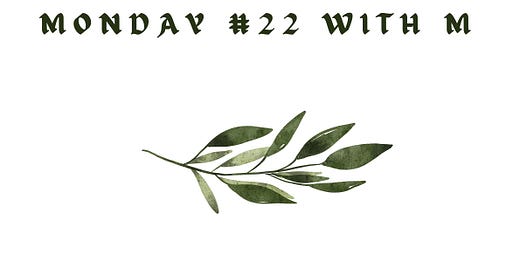Hi, and welcome to Monday #X with M. Each week, I’ll share some topics I’ve come across recently—an idea, article, or story—that caught my attention. I’ve learned so many interesting things from the people who’ve shared what they’ve found useful, and I consider that an act of kindness. This is my weekly care package to you, filled with fun and/or thoughtful discoveries, and sometimes a bit of venting about the craziness of the world to start your week on a good note.
I’ve chosen the #X format because I sometimes struggle with consistency, and I thought seeing the number grow each week would motivate me to keep going. Let’s get into it!
Spotlight Three
I. I Wrote This. Trust Me

Teachers not trusting students to complete their own homework is much older than the ChatGPT era. I remember writing an essay in my sophomore year of college, I think it was about traffic and metropolitan areas, and the instructor asked me to read it aloud to the class and then accused me of plagiarism. I had spent hours writing that essay because I knew the instructor to be an asshole and didn’t want to give him an excuse to embarrass me in front of everyone, and here I was anyway. I remember feeling frozen, and I just said, “That’s not true, I have done research for it, but this is my writing.” A couple of my classmates chimed in to back me up. But the damage was done to someone already living with imposter syndrome. You are not good enough to have written something like this on your own.
Today, AI-detection tools in the education system are doing the same thing, and many hardworking students are accused of cheating on a daily basis. According to this New York Times article:
Generative A.I. tools including ChatGPT are reshaping education for the students who use them to cut corners. According to a Pew Research survey conducted last year, 26 percent of teenagers said they had used ChatGPT for schoolwork, double the rate of the previous year. Student use of A.I. chatbots to compose essays and solve coding problems has sent teachers scrambling for solutions. But the specter of A.I. misuse, and the imperfect systems used to root it out, may also be affecting students who are following the rules. In interviews, high school, college, and graduate students described persistent anxiety about being accused of using A.I. on work they had completed themselves — and facing potentially devastating academic consequences.
Students are now coming up with solutions on how to defend themselves, and some of these are quite interesting:
In response, many students have imposed methods of self-surveillance that they say feel more like self-preservation. Some record their screens for hours at a time as they do their schoolwork. Others make a point of composing class papers using only word processors that track their keystrokes closely enough to produce a detailed edit history.
The fact is, those A.I. detection services could be wrong and unjust, as they mostly target non-native speakers as suspects. As a non-English speaker, I now use A.I. the same way I used Grammarly, but more efficiently. But there is a chance my writing could get flagged as A.I.-generated. Is that fair?
A new study of a dozen A.I.-detection services by researchers at the University of Maryland found that they had erroneously flagged human-written text as A.I.-generated about 6.8 percent of the time, on average. ‘At least from our analysis, current detectors are not ready to be used in practice in schools to detect A.I. plagiarism,’ said Soheil Feizi, an author of the paper and an associate professor of computer science at Maryland.
The irony here is the same teachers and educators who accuse their students of being lazy and using A.I. to do their work for them are not putting in the effort to know their students well enough to detect their voices in their writings. They rely on A.I. to do their job for them.
More students are speaking up against this unfair approach, and there are people out there who care enough to come up with creative ways to support their students. Kathryn Mayo, a professor at Cosumnes River College in Sacramento, is one example:
She has since changed some of her assignment prompts to make them more personal, which she hopes will make them harder for students to outsource to ChatGPT. She tries to engage any student whom she seriously suspects of misusing A.I. in a gentle conversation about the writing process. Sometimes students sheepishly admit to cheating, she said. Other times, they just drop the class.
II. Oh, Don’t Be So Judgy!

Unless you are watching a reality TV show, where people consciously have made a choice to put themselves in the position of being judged, you should try your best to steer clear from jumping to conclusions. This article talks about some ways to do that:
Regularly condemning others can reduce your empathy, make you less receptive to new perspectives and leave you more prone to reactive responses, said Sanam Hafeez, a neuropsychologist in New York City. And research suggests that the more you judge, the worse you feel.
Notice when you’re judging.
Catch yourself in the act, take a moment to slow down and check in.
Dr. Hafeez recommended asking yourself: Why does this matter to me? Am I simply observing, or am I layering on my own meaning? Is my judging thought actually about this person — or is it about how I feel about myself?
Explore your reaction.
It could be our own insecurities playing tricks on us. It’s important to understand what triggers we are experiencing in that moment. The next time you’re being judgmental, turn the lens on yourself, said Erica Schwartzberg, a psychotherapist in New York City, and figure out what is prompting these feelings.
Swap judgment for curiosity and empathy.
Try to question instead of presume. Never think you know what is going on in other people’s lives.
Curiosity can help “develop compassion,” Dr. Hafeez said. For example, instead of assuming that a colleague who fails to meet deadlines is careless, “question whether there are hidden factors influencing their behaviour, like personal challenges,” she said.
III. When Family Drama Knows No Borders

I remember when I was a kid, there were a few popular columns in well-known newspapers and magazines that would address questions from readers. It’s been years since I’ve read or thought about any of them. This week, I came across a popular section on the New York Times website called Social Q’s, which serves the same purpose. This time around, I’m looking at it from a different lens. You know, as a writer and storyteller, you always look for prompts and bits and pieces to include in your stories? This is a gold mine for that. You can use any of these stories and turn them into bits, dialogues, or character backgrounds.
As a Middle Eastern woman, the stories I used to read back home were mostly about in-law issues, which is typical and has good cultural and historical reasons behind it. But apparently, in the Western world, people are struggling with the same issues. Like one story I read where a reader asks for help setting boundaries with her husband’s mother, who has floated the idea of a lengthy stay with the couple after the arrival of their firstborn, and she is insisting of being in the delivery room with them (Yeesh!).
Well, granted, I don’t know the background of the person who wrote this. They might come from the same culture as me. But it was fascinating for me to read.
On a Brief Note
Hello Sunshine, Goodbye Cozy Layers
The warm weather is finally here, and the cold, grey, white-sky days are gone. I was thinking about this just yesterday—how much happier and more alive people seem to be on warm days. The city comes to life, people are wearing light and colourful clothes, and everything feels shiny and vibrant. It could also be me projecting my own happiness and comfort onto others. But anyway, it’s time to bring out the sundresses, cotton jumpsuits, and skirts, and say goodbye to comfy, cozy, warm clothes. Here are some tips to make sure you’re doing it properly.
Start with a clean closet: Dust can attract moths and even stain silk so vacuum your closet frequently.
Wash and dry clothing thoroughly: After laundering clothing, make sure it’s completely dry before packing it away. Moisture can stain or even distort the shape of a garment and also draws moths.
Fold and check: Wool and silk are especially prone to stretching out. So instead of hanging clothes, fold them loosely, layering in acid-free tissue paper “wherever the garment touches itself” to avoid deep creases.
Choose your containers wisely: When packing away clothes for just a few months, airtight plastic can help keep moths out.
Beware of basements: They’re typically too humid, making them breeding grounds for mold and moths, but preferable to attics, where the temperature tends to fluctuate wildly, causing fabrics to break down and shrink.
Toss those mothballs: Natural repellents like cedar and lavender sachets can offer some protection.
Open with care: Come fall, make sure to inspect your stored silks and woolens for damage before putting them back in rotation.
Words Worth Sharing
Hope is like a road in the country; there was never a road, but when many people walk on it, the road comes into existence.
Lu Xun
This is it for this week’s edition of Monday #X with M. If something here made you think, smile, or sparked your curiosity, consider sharing it with someone who might enjoy it too. You never know whose day you might brighten with a thoughtful word or idea—it’s a small act of kindness that can go a long way. See you next Monday!




